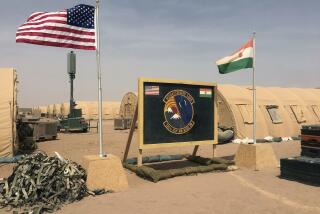S. Africa Troops Leave Angola After Long Conflict With Namibia Rebels
- Share via
OSHIKANGO, Namibia — South Africa withdrew its last combat troops from Angola on Wednesday after nearly a decade of cross-border operations there against Namibian guerrillas and, at times, against Angolan forces as well.
Led by a small brass band playing sentimental favorites such as “Clementine,” a contingent of 500 men crossed the border here on foot and in armored cars from southern Angola.
That completed a disengagement begun in February, 1984, after a final major South African operation in which an armored spearhead of more than 2,000 troops drove more than 100 miles into Angola.
South African Foreign Minister Roelof F. Botha said earlier this week that he hoped the withdrawal would promote negotiations on independence for Namibia, which Pretoria administers as South-West Africa. He said he hoped it also would encourage Angola to agree to a sharp reduction in the 30,000 Cuban troops whose presence in Angola is a major issue in the Namibian talks.
Troops Could Go Back
“The political advantages are greater than the security risk,” he said in Cape Town in announcing the pullout.
However, Gen. Constand L. Viljoen, chief of the South African defense forces, warned at a press conference here that the troops could be sent back at any time if Namibian guerrillas of the South-West Africa People’s Organization, known as SWAPO, re-establish major bases in Angola.
“We have demonstrated willingness, not weakness,” Viljoen said. “We are as strong as before and as determined as before to defend the people of South-West Africa against SWAPO.”
South Africa probably would adopt a policy of “hot pursuit” to deal with serious SWAPO attacks in Namibia, other senior government officials said, and would undertake preemptive strikes against SWAPO military buildups in Angola, particularly if the guerrillas had Angola’s active or tacit assistance.
“I have no doubt that we have the determination to reopen the military option,” Viljoen commented, “but I sincerely hope that this will not be necessary.”
Hopes Lessons Learned
Recalling South Africa’s operations in Angola since 1975, when the current Marxist government came to power in the former Portuguese colony, Viljoen said he hopes that both sides have learned from their mistakes.
The past year, the first in a decade in which there were no hostilities between the two countries, saw the development of a working relationship between them in an American-mediated joint monitoring commission supervising South Africa’s withdrawal, according to Viljoen.
The South African withdrawal stalled last May at Ngiva, 25 miles north of the border, as Pretoria sought to trade its final pullout and the military advantages it would lose for political gains in negotiations with the Angolan government in Luanda.
Meanwhile, it has used its cross-border positions to considerable effect in “blunting” SWAPO’s current rainy season offensive, killing a reported 250 guerrillas since the beginning of this year.
Viljoen said the troops withdrawn Wednesday were the last forces South Africa had in Angola except for two platoons, numbering about 60 men, stationed at a joint Angolan-Namibian hydroelectric project at Calueque, about 60 miles north of the border, under an informal security arrangement.
Four Angolan officers, members of the joint monitoring commission, did not dispute Viljoen’s announcement but declined to comment any further.
Monitoring Commission
Although the United States mediated and signed the February, 1984, Lusaka agreement under which the South African withdrawal took place, no American diplomats were present here to witness the pullout, as they had been at earlier stages of the agreement.
The joint Angolan-South African monitoring commission, which has been supervising the cease-fire, will continue to operate here for 30 days while the two countries discuss future relations.
South Africa has sought, but so far failed, to get Angolan agreement to transform the group into a permanent border commission that could also deal with broader political tasks.
The South African withdrawal came in the midst of other moves over Namibian independence.
Today or Friday, South African President Pieter W. Botha is expected to restore a large measure of self-government to the vast but sparsely populated desert territory, which South Africa administers in defiance of the United Nations under an outdated League of Nations mandate. He reportedly will also emphasize his country’s commitment to bring Namibia to independence under a U.N. plan with free elections.
Meanwhile, both South Africa and Angola are considering an American proposal, made a month ago, to resolve such difficult issues as the Cuban presence in Angola and thus speed Namibian independence.
More to Read
Sign up for Essential California
The most important California stories and recommendations in your inbox every morning.
You may occasionally receive promotional content from the Los Angeles Times.













